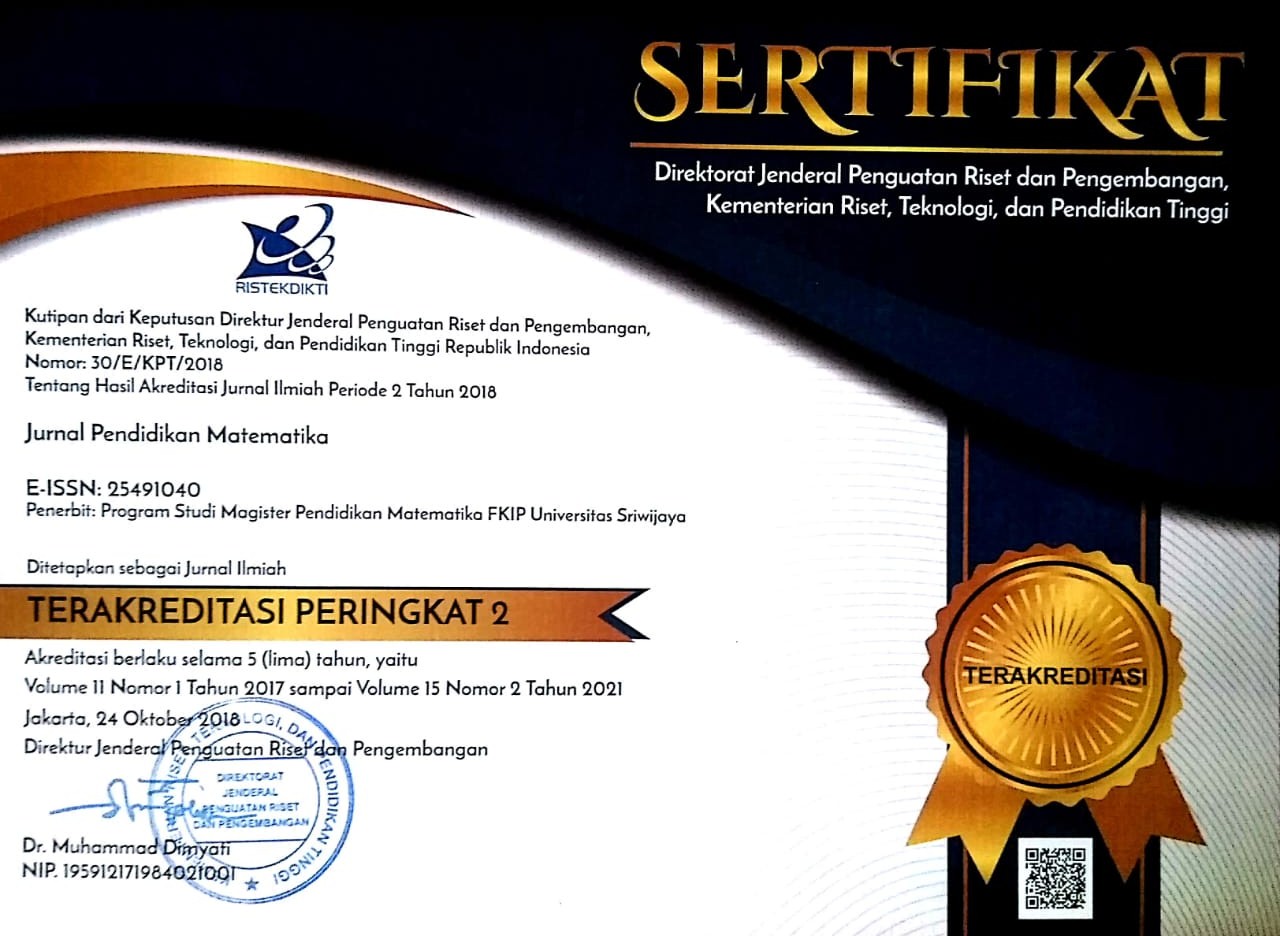Didactic Design of the Concept of Surface Area of Flat-Sided Prism Based on van Hiele’s Theory in Online Learning
Abstract
This research aimed to develop a didactic design of the concept of the surface area of a flat-sided prism by considering the stages of van Hiele’s theory as a learning trajectory. The didactic design of the concept of the surface area of a flat-sided prism based on van Hiele’s theory has been adapted to the pandemic situation and implemented to online learning. The research method employed was a qualitative method with data collected through observation, interviews, and documentation. The initial step in this research was to test the concept of the surface area of a flat-sided prism on 53 9th-grade students for the 2019/2020 school year to identify learning obstacles. Following the identification of the learning obstacles, an initial didactic design was then drawn up by applying the phases in van Hiele’s model of geometric thinking. The didactic design prepared was subsequently implemented online to 8th-grade junior high school students. The results of the implementation of the didactic design were analyzed as the final product. The conclusion from this research is that by using a didactic design that considers the stages of van Hiele geometry in understanding the concept of surface area of a flat-sided prism, it can help students understand the concept of a flat-sided prism correctly. It was found that students' understanding of the concept of the surface area of a prism improved from visual level to informal deduction.
Keywords
Full Text:
PDFReferences
Adkhadiah, A., Khusniah, R., & Nurmalitasari, D. (2018). Analysis of errors in word problems on the topic of 2D space class VII in secondary school number 2 Bangil Pasuruan Regency [in Bahasa]. Konvergensi Sains & Humaniora, 1(1), 345-362.
Aziiza, Y. F., & Juandi, D. (2021). Student’s learning obstacle on understanding the concept of prism surface area. Journal of Physics Conference Series, 1806(1), 012115. https://doi.org/10.1088/1742-6596/1806/1/012115.
Crowley, M. L. (1987). The van Hiele model of the development of geometric thought. In Lindquist, M. M. (Eds), Learning and Teaching Geometry (pp. 1 – 16). Reston, VA.
Dhungana, S. (2021). Problems in Learning Geometric Theorems In Secondary Schools: A Mixed Method Study. Doctoral Dissertation. Kathmandu University. https://doi.org/10.13140/RG.2.2.17101.36322
Hikmiah, A. N. U. (2013). Improving the learning outcomes in determining the properties of 3D space using skewer media in primary school [in Bahasa]. Jurnal Penelitian Pendidikan Guru Sekolah Dasar, 1(2), 1-10.
Islami, M. D., Sunardi, S., & Slamin, S. (2018). The mathematical connections process of junior high school students with high and low logical mathematical intelligence in solving geometry problems. International Journal of Advanced Engineering Research and Science, 5(4), 237427. https://dx.doi.org/10.22161/ijaers.5.4.3
Kabaso, M., & Chinamasa, E. (2020). Ordinary Level Students’perceived Errors In Earth Geometry: Implications For Instructions. ISSN: 2582-0745.
Kemendikbud. (2014). Permendikbud No 58 Tahun 2014 tentang Kurikulum 2013 Sekolah Menengah Pertama/Madrasah Tsanawiyah. Jakarta: Menteri Pendidikan dan Kebudayaan Republik Indonesia.
Litbang Kemendikbud. (2019). National Exam Results Report 2018/2019 [in Bahasa]. Badan Standar, Kurikulum, dan Asesmen Pendidikan Kementerian Pendidikan, Kebudayaan, Riset, dan Teknologi. http://litbang.kemdikbud.go.id.
Mayberry, J. & College, G. (1983). The van hiele levels of geometric thought in undergraduate preservice teachers. Journal for Research in Mathematics Education, 14(1), 58-69. https://doi.org/10.2307/748797.
Madimabe, M. P., Omodan, B. I., & Tsotetsi, C. T. (2020). Indigenous Knowledge as An Alternative Pedagogy to Improve Student Performance in The Teaching and Learning of Mathematical Geometry In Tvet College. Proceedings of ADVED, 2020(6th).
Mulyani, E. (2017). Design didactic on surface concept of trapezoidal area at secondary school mathematics learning [in Bahasa]. Supremum Journal of Mathematics Educatio, 1(2), 79-87. https://doi.org/10.35706/sjme.v1i2.752.
Murdiyanto, T. & Mahatama, Y. (2014). Development of math props to increase interest and motivation in learning math of elementary school learners [in Bahasa]. Sarwahita, 11(1), 38-43. https://doi.org/10.21009/sarwahita.111.07.
Ristianti, T. (2019). Analysis of Learning Obstacles and Didactic Surface Area Concepts of Trapezoids on Mathematics Learning [in Bahasa]. Unpublished Bachelor Thesis. Siliwangi: Universitas Siliwangi.
Özerem, A. (2012). Misconceptions in geometry and suggested solutions for seventh grade students. Procedia - Social and Behavioral Sciences, 55, 720–729. https://doi.org/10.1016/j.sbspro.2012.09.557.
Rohendi, D., Septian, S., & Sutarno, H. (2018). The use of geometry learning media based on augmented reality for junior high school students. IOP Conference Series: Materials Science And Engineering, 306(1), 012029). IOP Publishing.
Sidik, M. J., Hendriana, H., & Sariningsih, R. (2018). Analysis of students' mistakes of grade ix secondary school on 3D space materials in solving critical thinking problems. Jurnal Pembelajaran Matematika Inovatif, 1(5), 837-846. http://dx.doi.org/10.22460/jpmi.v1i5.p837-846.
Sumalwan., Anggo. M., & Ikhman. (2014). Analysis of error in solving 3D space problems for 8th class student at secondary school number 14 Kendari. Jurnal Penelitian Pendidikan Matematika, 2(2).
Suryadi, D., & Suratno, T. (2013). Metapedadidaktik dan Didactical Design Research dalam Implementasi Kurikulum dan Praktik lesson study. Proceedings of the Seminar Nasional Matematika dan Pendidikan Matematika. Surabaya: Universitas Negeri Surabaya.
Suwangsih, E. & Tiurlina. (2006). Mathematical Learning Model. Bandung: UPI Press.
Suwito, A. (2018). Analysis of thinking geometrically in solving algebraic problems in class VIII [In Bahasa]. Proceedings of the National Seminar of Etnomatnesia, 64–69.
Vojkuvkova, I. (2012). The van Hiele model of geometric thinking. Proceedings of Contributed Papers WDS’12.
Yadav, D. K. (2019). Experiential Learning and Geometry teaching: A call to action. Think India Journal, 22(28), 32-36.
Yuniarti, Y. (2016). Indonesian Realistic Mathematics Education (PMRI) To Improve Understanding of Geometry Concepts in Elementary Schools [in Bahasa]. EduHumaniora: Jurnal Pendidikan Dasar Kampus Cibiru, 3(2).
DOI: https://doi.org/10.22342/jpm.16.1.13789.73-88
Jl. Srijaya Negara, Bukit Besar
Palembang - 30139 Indonesia
Jurnal Pendidikan Matematika is licensed under a Creative Commons Attribution-NonCommercial-ShareAlike 4.0 International License.
Indexed in:


